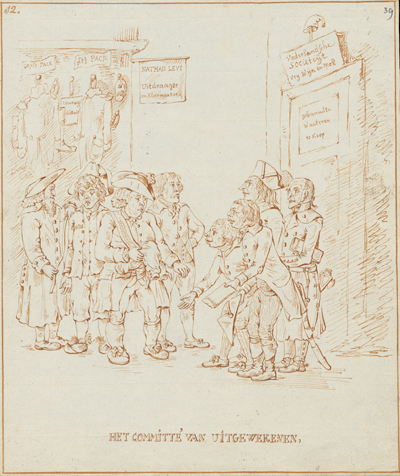Het Committé van Uitgeweekene
This is the twelfth plate of a twenty plate series, Hollandia Regenerata, etched by Gillray based on drawings by the Swiss soldier, painter, and caricaturist, David Hess. For more about David Hess, and the political and artistic context of the series satirizing the newly-created and French-supported Batavian Republic, see my Introduction.
The title can be translated as "The Committee for Refugees" The Batavian Revolution of 1795 had been preceded by earlier unsuccessful attempts in the 1780s and 1793 to free the Netherlands from the autocratic rule of William of Orange. After those conspicuous failures, the Batavians, as they called themselves, had to flee the country, seeking safe havens wherever they could to continue their struggle against the Orangists. But with the success of the 1795 Revolution, many of these Patriots returned to the country as heroes to the cause, but in Hess's view, looking for an easy payout from the Committee of Refugees.

Het
Committé van Uitgeweekene
[1796?]
© Trustees of the British Museum
Four of these Patriots appear at the door of the Fatherland Society (which doubles as a liquor store) with their requests for assistance in hand. The Fatherland Society was one of many Patriotic societies and reading clubs during the 1780s and 1790s which met to discuss democratic idealsand to oppose the Prince of Orange. It was, in fact, shut down in 1787, but arose again under a new name. One of them, as the "Explanation" suggests, carries in his pocket a stolen carriage lantern which he hopes to sell in town. But, as we can see, the youngest refugee is being immediately fitted out by a Jewish tailor for a place in the combined French Batavian army. The available uniform models are hanging on the wall. They include only Captain's and Lieutenant's packs, suggesting that the returning Patriots will be re-entering the army as officers, not common foot soldiers, displacing fully-trained officers like Hess himself who was part of the mercenary Swiss Guard. Also on the wall are a large purse labeled "Miitary Courage" and a fiercely frowning mask. Both suggest the superficiality of the Batavian commitment to the war, since they are simply put on like the clothes and boots that are part of the military package.
As with all the plates in the series, the corresponding page to the image contains one or more appropriately ironic Biblical quotations in Dutch and English and a satiric "Explanation" in French. The Biblical quotation predicts an unwelcome outcome to the Batavian plan:
Proverbs, xiii. 21. "Evil pursueth sinners."
The tongue in cheek "Explanation." heaps praise upon the returning refugees, but suggests that their experience is in "serving Mercury," i.e. trickery and deception.
Les voila ! ces martires de la liberté! ces heros, connus sous le nom de Bataves, qui ont si bien merité de la patrie. Aussi le Committé les habille et les comble de ses bienfaits. Admiréz cette fierté républicaine dans le maintien de ces petitionnaires ! Ils sont prets à deffendre la patrie dans le sein de laquelle ils viennent de rentrer. Leur courage et leurs talens sont à toute epreuve. Si Mars n'a pas besoin de leur assistance, ils sont d'avance accoutumés à servir Mercure.
Note. La lanterne dans la poche d'un de ces officiers . Bataves tient à une anectodte véritable. Cet individu vint à 11 heures de la nuit chez un sellier à la Haye, pour l'engager d'acheter, à bas prix, deux lanternes de carosse. Quoique l'heure incongrüe pourrait don ner quelque soupçon, la charité Chrétienne nous def fend de croire qu'il les avait volées.
And here is my free English translation.
Behold these martyrs of liberty, these heroes, known as Batavians, who have from their country deserved so much. The Committee dresses them as well as showering them with benefits. Admire its republican pride in the maintenance of these petitionaries! They are ready to defend the homeland to which they have just returned. Their courage and talents will be put to the test. If Mars does not need their assistance, they are experienced in serving Mercury.
Note. The lantern in the pocket of one of these Batavian recruits is based on a true story. This individual came at 11 o'clock at night to a saddler's in The Hague, to try to sell him, at low prices, two carriage lanterns. Although the lateness of the hour would arouse some suspicion, Christian charity forbids us to believe that he stole them.

Het
Committé van Uitgeweekene
[1796?]
© Zentralbibliothek Zürich
Like most of the plates of Hollandia Regenerata, Gillray follows the Hess's drawing closely. The basic disposition of the figures and meaning of the print both derive from Hess, but Gillray has sharpened every line and, with a wonderful use of shading, given a depth and solidity to the background, foreground, and figures (especially their clothes) that is missing in the original Hess drawing.
Sources and Reading
- Commentary from the British Museum on Het Committé van Uitgeweekene.
- "Batavian Republic," Wikipedia
- "David Hess (painter)," Wikipedia
- "David Hess," SIKART Dictionary
- David Hess, Hollandia Regenerata (1797), Nawoord by Joost Rosendahl, Uitgeverij Vantilt, 2007
- Simon Schama, Patriots and Liberators: Revolution in the Netherlands 1780 - 1813, London, 1992
Comments & Corrections
NOTE: Comments and/or corrections are always appreciated. To make that easier, I have included a form below that you can use. I promise never to share any of the info provided without your express permission.